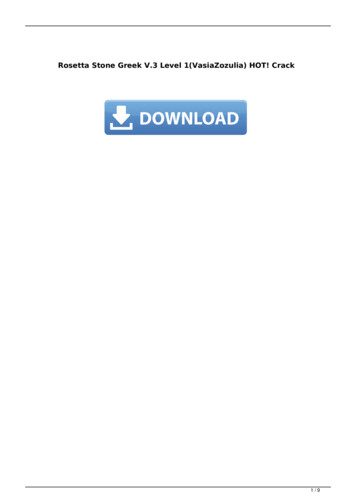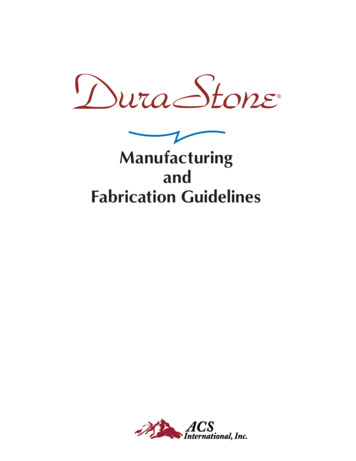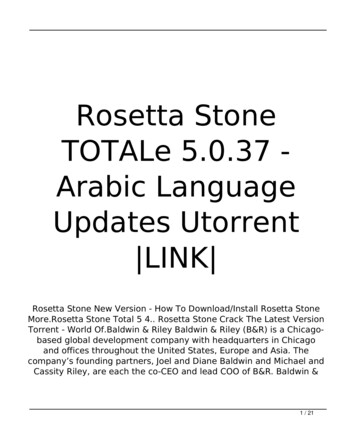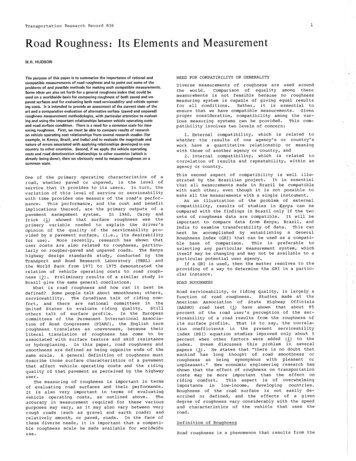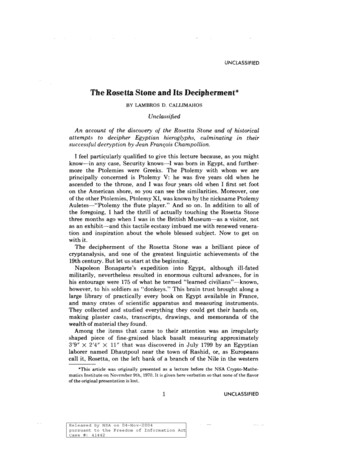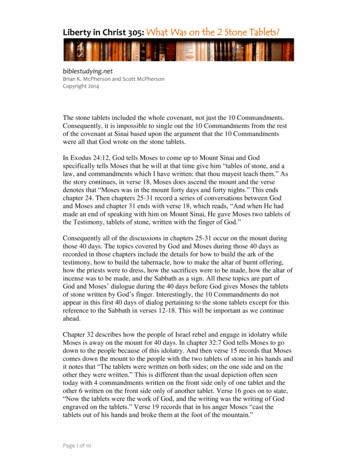
Transcription
Liberty in Christ 305: What Was on the 2 Stone Tablets?biblestudying.netBrian K. McPherson and Scott McPhersonCopyright 2014The stone tablets included the whole covenant, not just the 10 Commandments.Consequently, it is impossible to single out the 10 Commandments from the restof the covenant at Sinai based upon the argument that the 10 Commandmentswere all that God wrote on the stone tablets.In Exodus 24:12, God tells Moses to come up to Mount Sinai and Godspecifically tells Moses that he will at that time give him “tables of stone, and alaw, and commandments which I have written: that thou mayest teach them.” Asthe story continues, in verse 18, Moses does ascend the mount and the versedenotes that “Moses was in the mount forty days and forty nights.” This endschapter 24. Then chapters 25-31 record a series of conversations between Godand Moses and chapter 31 ends with verse 18, which reads, “And when He hadmade an end of speaking with him on Mount Sinai, He gave Moses two tablets ofthe Testimony, tablets of stone, written with the finger of God.”Consequently all of the discussions in chapters 25-31 occur on the mount duringthose 40 days. The topics covered by God and Moses during those 40 days asrecorded in those chapters include the details for how to build the ark of thetestimony, how to build the tabernacle, how to make the altar of burnt offering,how the priests were to dress, how the sacrifices were to be made, how the altar ofincense was to be made, and the Sabbath as a sign. All these topics are part ofGod and Moses’ dialogue during the 40 days before God gives Moses the tabletsof stone written by God’s finger. Interestingly, the 10 Commandments do notappear in this first 40 days of dialog pertaining to the stone tablets except for thisreference to the Sabbath in verses 12-18. This will be important as we continueahead.Chapter 32 describes how the people of Israel rebel and engage in idolatry whileMoses is away on the mount for 40 days. In chapter 32:7 God tells Moses to godown to the people because of this idolatry. And then verse 15 records that Mosescomes down the mount to the people with the two tablets of stone in his hands andit notes that “The tablets were written on both sides; on the one side and on theother they were written.” This is different than the usual depiction often seentoday with 4 commandments written on the front side only of one tablet and theother 6 written on the front side only of another tablet. Verse 16 goes on to state,“Now the tablets were the work of God, and the writing was the writing of Godengraved on the tablets.” Verse 19 records that in his anger Moses “cast thetablets out of his hands and broke them at the foot of the mountain.”Page 1 of 10
Liberty in Christ 305: What Was on the 2 Stone Tablets?biblestudying.netAs the story continues, in chapter 33 Moses prays for God’s presence and thenchapter 34 records how God gives Moses a second pair of tablets. Chapter 34:1states, “the LORD said to Moses, ‘Cut two tablets of stone like the first ones, andI will write on these tablets the words that were on the first tablets which youbroke.” In verse 2, God continues and says, “So be ready in the morning, andcome up in the morning to Mount Sinai.” As verses 4-5 records, once againMoses ascends the mount just like before and God descends to the mount to meetwith Moses. Verses 6-26 record a discussion between God and Moses that coverstopics including God’s mercy, driving out the Canaanites and destroying theiraltars, prohibiting the making of molded images (which is the first of the 10commandments), how to keep the feast of Passover, how to keep the Feast ofPentecost, how to keep the Feast of Tabernacles, and prohibiting eating blood.This discussion runs up to verse 26. And then verse 27 states, “Then the LORDsaid to Moses, ‘Write these words, for according to the tenor of these words Ihave made a covenant with you and with Israel.” Finally, verse 28 concludes bysaying, “So he was there with the LORD forty days and forty nights; he neitherate bread nor drank water. And He wrote on the tablets the words of the covenant,the Ten Commandments.” There are several items worth noting here.First, apart from this summary reference at the end in chapter 34:28, there is noactual discussion of the 10 Commandments during the description of the second40 days of discourse except for the prohibition against idolatry in verses 13-17.Second, according to verse 28 “the words of the covenant” are written on thetablets, yet according to God in verse 27 the entire conversation in verses 6-26constitutes the words according to which God made the covenant with Israel. Inother words, verse 27 provides a contextual definition for the phrase “words of thecovenant” and defines them as the entirety of the 40-day conversation. This wouldimply that it was not just the 10 commandments that were written on the tabletsbut the entire discourse recorded in verses 6-26.What is most likely happening is that chapter 34 is an abridged parallel to theconversation that occurred during the previous 40 days as recorded in chapters 2531. An interesting question is why it would take another 40 days if all that Godwrote was the 10 Commandments? Clearly, God is repeating the entire event anddiscourse. What is most likely occurring here is two separate recordings of thehighlights of a dialogue that took 40 days, a dialogue that occurred twice becauseMoses broke the first set of tablets. Different portions of the covenant and dialogare recorded from both occasions but between the two of them we have the entireconversation recorded. And the entire conversation describes the commandmentsof the covenant including the sacrifices, the priesthood, and the festivals. In otherwords, the entire 40-days of dialogue are the “words of the covenant,” the wordsthat lay out the covenant. And all of these words are recorded on the tablets, notjust the 10 Commandments. And this is why the tablets are written on both sides.The repetition of the 40 days of dialogue before each set of tablets again suggeststhat it was the entire covenant revealed by God during the 40 days on the mountthat was on the tablets, not just the 10 Commandments.Page 2 of 10
Liberty in Christ 305: What Was on the 2 Stone Tablets?biblestudying.netIt is also necessary to discuss in further detail the assertion in chapter 32:15 thatthe tablets were covered in writing on both sides. This statement is meant toindicate that there is a great deal of writing on the tablets, not just 10 briefstatements. Revelation similarly reflects this way of expressing that there is alarge amount of writing when Revelation 5:1 records “a book written within andon the backside, sealed with seven seals.” The purpose of such phrases is not toconvey the idea that the text was written large so that it could be seen from adistance. Instead, such phrases are intended to convey that there is a very largeamount of writing, so much writing that every available surface is used. In fact,Exodus 32:15 repeats this twice for emphasis, saying, “The tablets were writtenon both sides; on the one side and on the other they were written.” Clearly, theauthor wanted to get across to his audience that there was a lot written on thesestone tablets and he did not want them to miss that point and think that only alittle or moderate amount of text on them.Moreover, to further substantiate this point, it is important to recall that theprimary purpose for the golden ark of the covenant was to carry these stonetablets. Below is an excerpt from Smith’s Bible Dictionary on this topic.“Ark of the Covenant – Ex. 25. I. Description.--It appears to have been an oblongchest of shittim (acaceai) wood, 2 1/2 cubits long by 1 1/2 broad and deep.II. Itspurpose was to contain inviolate the divine autograph of the two tables, that"covenant" from which it derived its title.” – Smith's Bible Dictionary, p. 53In a separate article on page 740, Smith’s delineates that one cubit is equivalent toroughly 19 inches. Consequently, being 2.5 cubits long but 1.5 cubits broad and1.5 cubits high, the ark would be about 4 feet long, about 2.5 feet wide, and about2.5 feet wide. 1 Kings and 2 Chronicles also attest that the primary purpose of theark was to contain the stone tablets, and both passages also highlight that only thetablets were in the ark, nothing else. Other items were placed in the ark at least fora time. Exodus 16:33-34 states that an “omer” of manna was at one time placed inthe ark. But that is only about 2 liters according to the Online Bible HebrewLexicon. This is roughly equivalent to placing a bottle of soda into a 25 squarefoot volume, leaving the majority of the space vacant. Hebrews 9:4 also indicatesthat Aaron’s staff was placed into the ark as well, but again this is not an item thatwould have occupied a great deal of space.This means that the volume of the ark was devoted to housing the tablets withlittle space needed for other items. Conversely, this would mean that the tabletsthemselves would be roughly 4 feet by 2.5 feet, in which case there would be 10square feet of surface on each side of the tablets. With 2 sides per tablet and 2tablets, that would be a total of nearly 40 square feet of surface area. Theimplication from Exodus 32:15 is that God filled nearly 40 square feet of writingarea with the words of his covenant with the Israelites. That is a lot of writing andcertainly the text intends to convey that much more than merely the 10Commandments were written on the stone tablets. Consequently, the dimensionsof the ark also corroborate the large amount of writing on the tablets and that theentire covenant was written on them, not merely the 10 Commandments.Page 3 of 10
Liberty in Christ 305: What Was on the 2 Stone Tablets?biblestudying.netMoreover, both 1 Kings 8 and 2 Chronicles 5 contain the phrase “the two tables ofstone, which Moses put there at Horeb, when the LORD made a covenant with thechildren of Israel.” This phrasing also suggests that the entire covenant describedby God to Moses over the 40 days of discourse on the mount were written on thestone tablets. Just as God said in Exodus 34:27-29, the words of the 40 days ofdialog were the words of the covenant and it was the words of the covenant thatwere written on the tablets.However, the counterargument could arise that in chapter 34:27, God tells Moses,to “Write these words.” By “these words” God is referring to the words that Godhad been speaking to Moses for the 40 days as recorded in verses 6-26 of thatsame chapter. Consequently, the objection is that it is Moses who writes thesewords, while God himself writes the 10 Commandments. However, verse 28states, “So he was there with the LORD for forty days and forty nights; he neitherate bread nor drank water. And He wrote on the tablets the words of the covenant,the Ten Commandments.” The first thing to notice here is that according to verse28, it is the same person who writes “the words of the covenant” and the “TenCommandments,” which would make it impossible to suggest that God wrote theTen Commandments and Moses wrote the rest of the words. There is also thequestion of who is doing the writing in verse 28. While the New King Jamesversion capitalizes the pronoun “He” in the latter part of the verse, the King JamesVersion does not. Of course, the grammar of the Hebrew does not indicate whichis correct, a capital “He” referring to God or a lowercase “he” referring to Moses.However, looking back to the first verse of the chapter, it is clear that verse 28 isreferring to God writing on the tablets because in verse 1 God promises to againwrite on the tablets all the things that were on the first set of tablets.While verse 27 seems to indicate that God also told Moses to write the words ofthe discussion, it seems clear that God himself wrote all the words of thediscussion on the two tablets just as he had done the first time. The simplesolution here is that we have two copies being made, one by God and one byMoses. And this makes sense. After all, everyone agrees that God himself wroteat least the 10 Commandments on the stone tablets, yet Moses himself recordedthe 10 Commandments in Exodus 20. So likewise, it would seem that Mosesrecorded the entire content of his dialogues with God over those 80 days and wehave those recordings from Moses in our current Pentateuch (the first five books)while God himself made his own recording of the same discussions and put it inhis own handwriting on the stone tablets. In these 80 days of dialogue, Goddefined the covenant. So the dialogues were the “words of the covenant” and bothMoses and God wrote their own, separate record of all the words spoken in those80 days defining the covenant. So, while Moses did write a copy of those words,Moses was not the one writing on the stone tablets. God was the one writing onthe stone tablets as clearly stated in Exodus 31:18, 34:1, Deuteronomy 9:10, and10:3-4. While the text of chapter 34:28 is quick to highlight for us that the 10Commandments are included among all the “words of the covenant” covered overthose 40 days, they were not the only commandments recorded.Page 4 of 10
Liberty in Christ 305: What Was on the 2 Stone Tablets?biblestudying.netThere are several other reasons reassuring us of this conclusion. First, the secondtablets were an exact copy of the first, as God himself plainly states in chapter34:1. This fact is confirmed in Deuteronomy 10:3-4. Yet in chapter 24:12, whenGod first announces that he will give Moses tablets of stone, God lists both “thelaw and commandments” as being on those tablets. There are 2 items mentionedhere. Since all parties agree that at least one of these items was written on thetablets and since both items are part of the same statement, we must conclude thatwhatever applies to one item in chapter 24:12 applies to the other. If one item (the10 Commandments) were on the tablets, then chapter 24:12 is indicating that theother item, the rest of the Law (defined over those 40 days) was also written onthe tablets. Again, this is most likely why the text denotes that the tablets werecovered on both sides with writing.In addition, the question might be asked why chapter 34:27 singles out the 10Commandments when it states, “He wrote on the tablets the words of thecovenant, the Ten Commandments.” The reason for this is simple. Verse 26 statesthat all the words God spoke over the 40 days were “the words of the covenant,”and consequently, when the original reader got to verse 27, it would have beenclear the “words of the covenant” on the tablets included all the words God hadspoken in verses 6-26. But as we mentioned before, verses 6-26 are most likelyonly highlights and the 10 Commandments are not covered in the highlights,except for a reference in verses 13-17 to the first commandment. Consequently,since the 10 Commandments were not recorded in the dialogue, it was necessaryfor the author to specifically include them here in the summary so that theaudience would know they, too, were included on the tablets containing all the“words of the covenant.”Of course, Exodus 34:27 is not the only occasion where the 10 Commandmentsare highlighted when the text mentions “words of the covenant” that were writtenon the tablets of stone. Deuteronomy 4:13 states, “And he declared unto you hiscovenant, which he commanded you to perform, ten commandments; and hewrote them upon two tables of stone.” Likewise, Deuteronomy 10:4 states, “Andhe wrote on the tables, according to the first writing, the ten commandments.”Why are the 10 Commandments specifically highlighted in such passages?Doesn’t this prove that only the 10 Commandments were on the tablets? Theanswer is “no” for a very simple reason that is obvious from the unfoldinghistorical narrative of these books.While the 10 Commandments are stated in chapter 20:1-17, it is not until fourchapters later in Exodus 24:12 that God first mentions to Moses that he will giveMoses 2 stone tablets, written by God himself. More importantly, God’s statementconcerning the stone tablets is presented in the text as part of a separate visitbetween God and Moses on the mount. We might call this separate visit, whichfollows after chapter 24:12, “God’s stone tablet discourse.” Exodus 25-31 recordsdialogue from this “stone tablet discourse” between God and Moses on the mount,concluding in chapter 31:18 with the statement that “he gave unto Moses, whenhe had made an end of communing with him upon mount Sinai, two tables oftestimony, tables of stone, written with the finger of God.” Most importantly, inPage 5 of 10
Liberty in Christ 305: What Was on the 2 Stone Tablets?biblestudying.netthe record of the “stone tablet discourse,” (this separate visit between God andMoses on the mount), the 10 Commandments do not appear, but instead we findonly a brief reference to the Sabbath commandment in chapter 31:12-18.Likewise, during the second 40 days of discourse preceding the replacement pairof stone tablets, the 10 Commandments do not appear in the discussion, butinstead we find only a brief reference to the first commandment in chapter 34:1317. The presence of the first commandment here might simply be due to the factthat the first set of tablets were destroyed because the people were committingidolatry, in which case, the presence of this command would not indicate asummary reference to the rest of the 10 Commandments. Rather, it might behighlighted here for emphasis in light of recent events. Likewise, the specificmention of the Sabbath during the first 40 day discourse might be due simply tothe fact that the people had previously had trouble with the Sabbath in Exodus 16,in which case the presence of this command during the first 40 days would alsonot indicate a summary reference to the rest of the 10 Commandments but ahighlight for emphasis.Consequently, if we set aside familiar misperceptions, the way that the textpresents the stone tablets written by God is that they are part of a separatedialogue, a separate set of declarations by God. And this is the way the storyoriginally unfolded for the Israelites. Consequently, stubborn individuals amongthe Israelites could have argued that since the 10 Commandments were not part ofthe episode in which God gave the stone tablets, therefore these particular 10 ruleswere not binding or part of the covenant. In conclusion, the most natural reasonwhy the 10 Commandments are repeatedly reinforced as being on the stone tabletsis not because they were the only thing on the tablets but because they were givenon a separate occasion, not during “God’s stone tablet discourse.” And, as such, itmight have been concluded that they were not on the tablets at all. In other words,the reason for highlighting that the 10 Commandments were on the tablets was toreinforce their inclusion alongside the rest of God’s declarations on the tablets,not to exclude the rest of God’s declarations from the tablets.In addition, there is also another reason why the 10 Commandments arehighlighted so often whenever the stone tablets are mentioned. In God’s firstmention of the stone tablets, God promises to give these tablets as a record of his40 days of dialog with Moses. In Exodus 24:12 God says to Moses, “Come up tome into the mount, and be there: and I will give thee tables of stone, and a law,and commandments which I have written.” Consequently, when passages such aschapter 34:27 say things like, “He wrote on the tablets the words of the covenant,the Ten Commandments” they may simply be repeating God’s delineation of thetwo items He said would be written on the tablets in chapter 24:12, the law andcommandments. As such, the phrase “the covenant” would refer to chapter 24’sphrase “the law” and likewise the phrase “ten commandments” would simplycorrespond to chapter 24’s phrase “commandments.”While this alternate interpretation would perhaps allow for the 10 Commandmentsto be listed separately than (and perhaps conceptually distinguished from) the restof the law, two facts would remain clear. First, this alternate interpretation wouldPage 6 of 10
Liberty in Christ 305: What Was on the 2 Stone Tablets?biblestudying.netstill reinforce that the entire Law, not merely the 10 Commandments, were writtenon the stone tablets. And second, rather than providing a basis for dividing the 10Commandments from the Law, the fact that the 10 Commandments are written byGod right next to the rest of the law on the stone tablets actually reinforces theeternal and indivisible link between the 10 Commandments and the Law. Finally,this correlation between “the law” and “the covenant” resonates with God’sassertion at the end of the second 40-day discourse in chapter 34:27-29 that thewords of the preceding dialog were the words of the covenant and that all thesewords of the covenant were written on the tablets of stone. This discourseincluded such concepts as God’s mercy, driving out the Canaanites and destroyingtheir altars, prohibiting the making of molded images, how to keep the feast ofPassover, how to keep the Feast of Pentecost, how to keep the Feast ofTabernacles, and prohibiting eating blood, which indicates that all of these itemswere written on the tablets.Ultimately, there are two options for why the Ten Commandments are oftenspecifically identified when the tablets are mentioned. The purpose may havebeen to highlight the inclusion of the 10 Commandments as part of the Law sincethey were originally given separately from the “stone tablet discourse.” Or, thepurpose may have been to reflect God’s description in Exodus 24:12 that thetablets would contain both a covenant law and commandments. In fact, these twoexplanations probably go hand and hand so that the basis for the conceptualdistinction between the “law” and “the commandments” stemmed from theoriginal chronological separation between the initial pronouncement of the TenCommandments in Exodus 20 and stone tablet discourse between God and Moseson a different occasion later in Exodus. In either case, we can see that explicitreferences to the 10 Commandments when the stone tablets are mentioned do notin any way necessitate that the 10 Commandments were the only items on thetablets.There is one other objection that could be offered to this theory that the entirecovenant was written on the two tablets of stone, not only the 10 Commandments.The objection comes out of Deuteronomy 5:1-22, which re-records what occurredin Exodus 20 when God descended upon Mount Sinai before the assembly of theIsraelites. Verses 6-21 of Deuteronomy recount the 10 Commandments. Thenverse 22 concludes with an interesting statement: “These words the LORD spakeunto all your assembly in the mount out of the midst of the fire, of the cloud, andof the thick darkness, with a great voice: and he added no more. And he wrotethem in two tables of stone, and delivered them unto me.” At first glance this mayseem to indicate that the only thing God spoke and the only thing God recordedon the tablets was the 10 Commandments, particularly the phrase “and he addedno more.”However, a closer examination of Exodus 20 reveals this is not the case. InExodus 20:1-17, God descends to the mount for the first time and speaks the 10Commandments. But in verse 18 a critical event happens. Having heard God’swords up to this point, the people ask Moses in verse 19 to go up to God so thatthey won’t have to hear God anymore for themselves. Although God says a greatPage 7 of 10
Liberty in Christ 305: What Was on the 2 Stone Tablets?biblestudying.netdeal more (the sum of which is recorded in verses 22-26 of chapter 20 and onthrough chapter 21-23), the only portion that the people heard for themselves wasthe 10 Commandments. Consequently, Deuteronomy 5:22 is not saying that allGod spoke was the 10 Commandments. We know that wasn’t the case becauseExodus 20-23 records a great deal more that God spoke one on one with Mosesfrom the mount after the people asked God to stop speaking to them directly.When verse 22 states, “These words the LORD spake unto all yourassembly and he added no more,” this is simply a reference to God “adding nomore” to what the people heard. It’s a reference to the people’s plea for God tostop talking to them directly because they were terrified, a request which Godgranted. It is not an assertion that God added nothing more than the TenCommandments to his law or covenant with Israel.Likewise, when verse 22 goes on to state that God wrote these 10 Commandmentson tablets of stone, it is not indicating that this was all God wrote on the tabletsand that he “added no more” to the stone tablets beside the 10 Commandments.Instead, Moses is simply indicating to the people that the 10 Commandments,which were all that the people heard for themselves before God stopped talking attheir request, were included on the tablets of stone. But just as we know that Goddid “add more” to what “he said” that same day beyond the 10 Commandments,we also can conclude that what “God wrote” on the tablets of stone likewiseincluded more than just the 10 Commandments. In short, the phrase “he added nomore” does not limit what God said or wrote that day or in later chapters duringthe 2 separate 40-day conversations with Moses on the mount. It merely refers tothe limited portion that the people heard from God for themselves when theyasked God to say no more to them directly.In fact, the remaining verses of Deuteronomy 22 starting in verse 23 recounts thepeople’s request not to hear God’s words for themselves. Furthermore,Deuteronomy 5:30-31, God himself draws the distinction that while the peopleonly heard a part before they asked God to stop speaking, when Moses came up asthe people had requested, God would tell him the “whole” or “all” of the rest ofthe Law. So, clearly God said more and wrote more on the tablets than just the 10Commandments, which is simply the only part the people could bear to hearbefore they asked God to say no more. In addition, this interpretation is clearlyborn out by the New Jewish Publication Society’s translation of the TANAKH(although the verse numbers are slightly different than the KJV and NKJV) inwhich this verse reads, “as for thee, stand though here by Me, and I will speakunto thee all the commandment, and the statutes, and the ordinances, whichthough shalt teach them.”Lastly, we should say that the New Testament confirms that the entire Law ofMoses was written on the stone tablets. In Jeremiah 31:31-34, Ezekiel 11:17-20,and Ezekiel 36:24-27, God describes a new covenant written on the people’shearts in place of the old covenant that was written on “hearts of stone.” Thesepassages are quoted by Paul in 2 Corinthians 3:3-14 (especially verse 3, 7, 11, 1314) and Hebrews 8:6-13 (especially verses 7-11, 13). The phrasing “written onhearts of stone” is explicit in Ezekiel and implied by contrast to the phrase “writePage 8 of 10
Liberty in Christ 305: What Was on the 2 Stone Tablets?biblestudying.neton hearts” in Jeremiah. These prophetic phrases are clearly a reference back to thestone tablets on Mount Sinai, particularly since both passages discuss thecovenant God made with the fathers of Israel. And not only is it clear that Ezekieland Jeremiah have the stone tablets in mind, but certainly Paul’s reference in 2Corinthians 3:3 is explicit that Ezekiel and Jeremiah had the stone tablets in view.Consequently, here Paul’s argument that the Law of Moses has been removed isbased upon these Old Testament statements declaring the removal of the “stonetablets.” After all, how would the removal of stone tablets signify the removal of acovenant that was not written on them? Quite simply, such arguments from Paulare only possible if Paul himself believed that the Law of Moses (and not just the10 Commandments) was written on the stone tablets and, therefore, the removalof the stone tablets necessarily demonstrated the abolishing of the entire covenantof the Law of Moses written upon them.At this point, it is important to address one additional justification that could beoffered for treating the 10 Commandments separately from the rest of the SinaiCovenant. Specifically, can the 10 Commandments be distinguished on thegrounds that they are the “Moral Law” or “Moral” aspect of the Law of Moses?Furthermore, does the fact that they deal with moral laws provide a basis forasserting that the 10 Commandments are necessarily eternal and unchanging?There are 3 facts that prevent dividing the 10 Commandments from the rest of theLaw of Moses on these grounds.First, the 10 Commandments themselves clearly contain a command thatestablishes a holy day (the Sabbath) and what must be done on that day (restinstead of work). Consequently, if commands that establish holy days (as well aswhat can and cannot be done on such days) fall under the category of “moral”laws, then the entire portion of the Sinai Covenant instituting new moon andannual feast days (as well as all the ceremonial activities required for each day)also must be deemed “moral laws.” Consequently, nearly the entire ceremonialand sacrificial law would also fall under the category of the “moral law.” And assuch, it is impossible to divide the 10 Commandments from the rest of the SinaiCovenant simply on the basis that the 10 Commandments deal with “moral”issues.Second, there are other precepts in the Law of Moses that govern morality issuesbeside the 10 Commandments. For instance, the Law of Moses contains the legalcommands concerning rape, homosexuality, incest, and even divorce andremarriage, as well as other non-sexual issues. Surely, everyone will no doubtquickly agree that rape and homosexuality always have and always will beeternally wrong. But this is not the point. The point is that these commands areclearly not part of the 10 Commandments, yet they clearly deal with moral issues.And consequently, it is not possible to div
little space needed for other items. Conversely, this would mean that the tablets themselves would be roughly 4 feet by 2.5 feet, in which case there would be 10 square feet of surface on each side of the tablets. With 2 sides per tablet and 2 tablets, that would be a total of nearly 40 square feet of surface area. The


